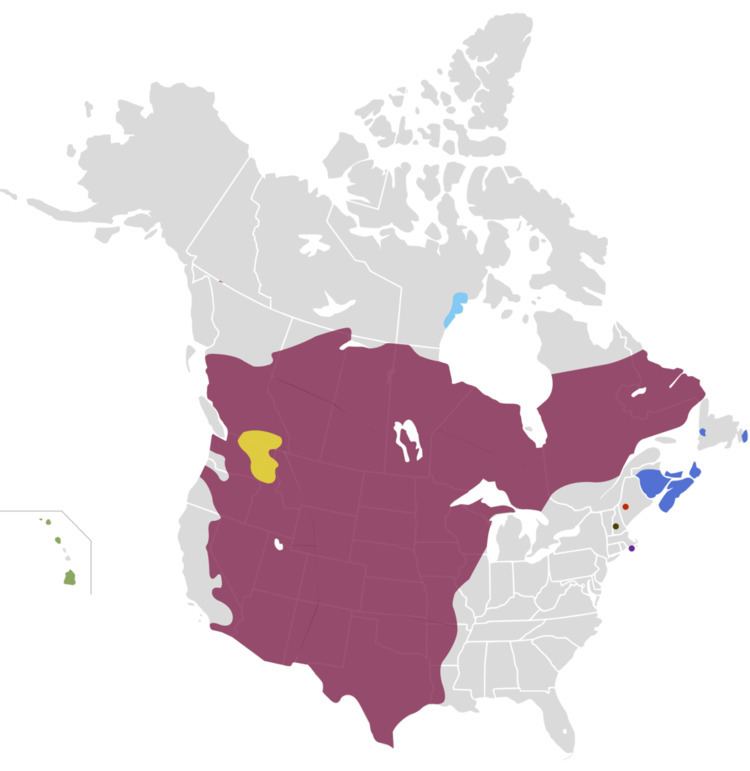Native to Canada, Mexico, USA | ||
 | ||
Region Central Canada and United States including the Great Plains and the Rocky Mountains region; northern Mexico Ethnicity Various North American Indigenous Peoples Native speakers Unknown (no date)75 users total (no date) Dialects Navajo Sign LanguageBlackfoot Sign LanguageCree Sign LanguageOjibwa Sign Language | ||
Plains Indian Sign Language (PISL), also known as Plains Sign Talk, Plains Sign Language and First Nation Sign Language, is a trade language (or international auxiliary language), formerly trade pidgin, that was once the lingua franca across central Canada, central and western United States and northern Mexico, used among the various Plains Nations. It was also used for story-telling, oratory, various ceremonies, and by deaf people for ordinary daily use. It is falsely believed to be a manually coded language or languages, however there is not substantive evidence establishing a connection between any spoken language and Plains Sign Talk.
Contents
The name 'Plains Sign Talk' is preferred in Canada, with 'Indian' being considered pejorative by many. Hence, publications and reports on the language vary in naming conventions according to origin.
History
Plains Sign Talk's antecedents, if any, are unknown, due to lack of written records. But, the earliest records of contact between Europeans and Indigenous peoples of the Gulf Coast region in what is now Texas and northern Mexico note a fully formed sign language already in use by the time of the Europeans' arrival there. These records include the accounts of Cabeza de Vaca in 1527 and Coronado in 1541.
As a result of several factors, including the massive depopulation and the Americanization of Indigenous North Americans, the number of Plains Sign Talk speakers declined from European arrival onward. In 1885, it was estimated that there were over 110,000 "sign-talking Indians", including Blackfoot, Cheyenne, Sioux, Kiowa and Arapaho. By the 1960s, there remained a "very small percentage of this number". There are few Plains Sign Talk speakers today in the 21st century.
William Philo Clark, who served in the United States Army on the northern plains during the Indian Wars, was the author of The Indian Sign Language, first published in 1885. The Indian Sign Language with Brief Explanatory Notes of the Gestures Taught Deaf-Mutes in Our Institutions and a Description of Some of the Peculiar Laws, Customs, Myths, Superstitions, Ways of Living, Codes of Peace and War Signs is a comprehensive lexicon of signs, with accompanying insights into indigenous cultures and histories. It remains in print.
Geography
Sign language use has been documented across speakers of at least 37 spoken languages in twelve families, spread across an area of over 2.6 million square kilometres (1 million square miles). In recent history, it was highly developed among the Crow, Cheyenne, Arapaho and Kiowa, among others, and remains strong among the Crow, Cheyenne and Arapaho.
Signing may have started in the south, perhaps in northern Mexico or Texas, and only spread into the plains in recent times, though this suspicion may be an artifact of European observation. Plains Sign Talk spread to the Sauk, Fox, Potawatomi, Cherokee, Chickasaw, Choctaw, and Caddo after their removal to Oklahoma. Via the Crow, it replaced the divergent Plateau Sign Language among the eastern nations that used it, the Coeur d'Alene, Sanpoil, Okanagan, Thompson, Lakes, Shuswap, and Coleville in British Columbia, with western nations shifting instead to Chinook Jargon.
The various nations with attested use, divided by language family, are:
A distinct form is also reported from the Wyandot of Ohio.
It is known that Navajo has a comparably sizeable population of individuals who can speak the Navajo dialect of Plains Sign Talk. There is also an unrelated sign language, Navajo Family Sign, in a clan of Navajos that has several deaf members.
There exists a variety of Plains Sign Talk within the Blackfoot Confederacy. Little is known about the language beyond that it is used by Deaf community members, as well as by the community at large, to pass on "oral" traditions and stories.
Phonology
There are four basic parameters of Plains Sign Talk: the location of the hand, its movement, shape, and orientation:
There may be other parameters, such as facial features. However, these function like suprasegmentals, and the four parameters listed above are the crucial ones.
Although the parameters of sign are listed separately below, in actuality they co-occur with the other parameters to make a single sign. It is not clear how many of the differences were distinctive (phonemic).
Handshape
The Bureau of American Ethnology published a glossary of Plains Sign Talk words that illustrate the handshapes involved. They assigned them alphabetic letters.
Location
Plains Sign Talk uses the following locations. The various neutral spaces are the most common places for signs to occur.
Orientation
These are the directions towards which the palm can face.
Movement
The movements below are found in Plains Sign Talk. They may be repeated in certain situations.
